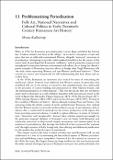Files in this item
Problematizing periodization : folk art, national narratives and cultural politics in early twentieth-century Romanian art history
Item metadata
| dc.contributor.author | Kallestrup, Shona | |
| dc.contributor.editor | Kallestrup, Shona | |
| dc.contributor.editor | Kunińska, Magdalena | |
| dc.contributor.editor | Mihail, Mihnea Alexandru | |
| dc.contributor.editor | Adashinskaya, Anna | |
| dc.contributor.editor | Minea, Cosmin | |
| dc.date.accessioned | 2022-07-08T14:30:07Z | |
| dc.date.available | 2022-07-08T14:30:07Z | |
| dc.date.issued | 2022-06-08 | |
| dc.identifier | 274252774 | |
| dc.identifier | b0b12c3d-651e-4964-89a5-99285bed480b | |
| dc.identifier.citation | Kallestrup , S 2022 , Problematizing periodization : folk art, national narratives and cultural politics in early twentieth-century Romanian art history . in S Kallestrup , M Kunińska , M A Mihail , A Adashinskaya & C Minea (eds) , Periodization in the art historiographies of Central and Eastern Europe . Studies in art historiography , Routledge Taylor & Francis Group , Abingdon, Oxon , pp. 192-213 . https://doi.org/10.5281/zenodo.5733327 , https://doi.org/10.4324/9781003178415-16 | en |
| dc.identifier.isbn | 9781032013848 | |
| dc.identifier.isbn | 9781003178415 | |
| dc.identifier.other | ORCID: /0000-0002-2484-561X/work/115630881 | |
| dc.identifier.uri | https://hdl.handle.net/10023/25637 | |
| dc.description | Funding: ArtHistCEE - Art Historiographies in Central and Eastern Europe An Inquiry from the Perspective of Entangled Histories (802700). | en |
| dc.description.abstract | This chapter explores how Romanian art historians of the early twentieth century used discussion of peasant art and architecture to confront and circumvent the hierarchical problems inherent in Western models of periodization. By reclaiming Romania’s own artistic traditions, both Byzantine and vernacular, the negative connotations of ‘belatedness’ were replaced by positive assessments of ‘atemporality’, mapping a different artistic cosmos whose value did not depend solely on its uncomfortable relationship with Western criteria of art. Focusing on a number of key accounts written for a Western readership, the chapter probes the efforts of Romanian art historians to encourage a fresh reassessment not just of the art produced in the Romanian territories, but also the frameworks for its discussion. For some, like Alexandru Tzigara-Samurcaş and Nicolae Iorga, this was bound up with the wider cultural-ideological project of Romania’s new political borders after the First World War. For others, like George Oprescu and his friend the French art historian Henri Focillon, it was part of a broader interwar effort to transcend political geographies of nation or race and embrace folk art within a unifying vision of humanity. | |
| dc.format.extent | 22 | |
| dc.format.extent | 7293106 | |
| dc.language.iso | eng | |
| dc.publisher | Routledge Taylor & Francis Group | |
| dc.relation.ispartof | Periodization in the art historiographies of Central and Eastern Europe | en |
| dc.relation.ispartofseries | Studies in art historiography | en |
| dc.subject | Folk art | en |
| dc.subject | Romania | en |
| dc.subject | Central and Eastern Europe | en |
| dc.subject | Nationalism | en |
| dc.subject | Art historiography | en |
| dc.subject | N Fine Arts | en |
| dc.subject | MCC | en |
| dc.subject.lcc | N | en |
| dc.title | Problematizing periodization : folk art, national narratives and cultural politics in early twentieth-century Romanian art history | en |
| dc.type | Book item | en |
| dc.contributor.institution | University of St Andrews. School of Art History | en |
| dc.identifier.doi | https://doi.org/10.5281/zenodo.5733327 | |
| dc.description.status | Peer reviewed | en |
| dc.identifier.url | https://doi.org/10.4324/9781003178415 | en |
| dc.identifier.url | https://discover.libraryhub.jisc.ac.uk/search?isn=9781032013848&rn=1 | en |
This item appears in the following Collection(s)
Items in the St Andrews Research Repository are protected by copyright, with all rights reserved, unless otherwise indicated.

